Rumalef 20 Tablet 30's
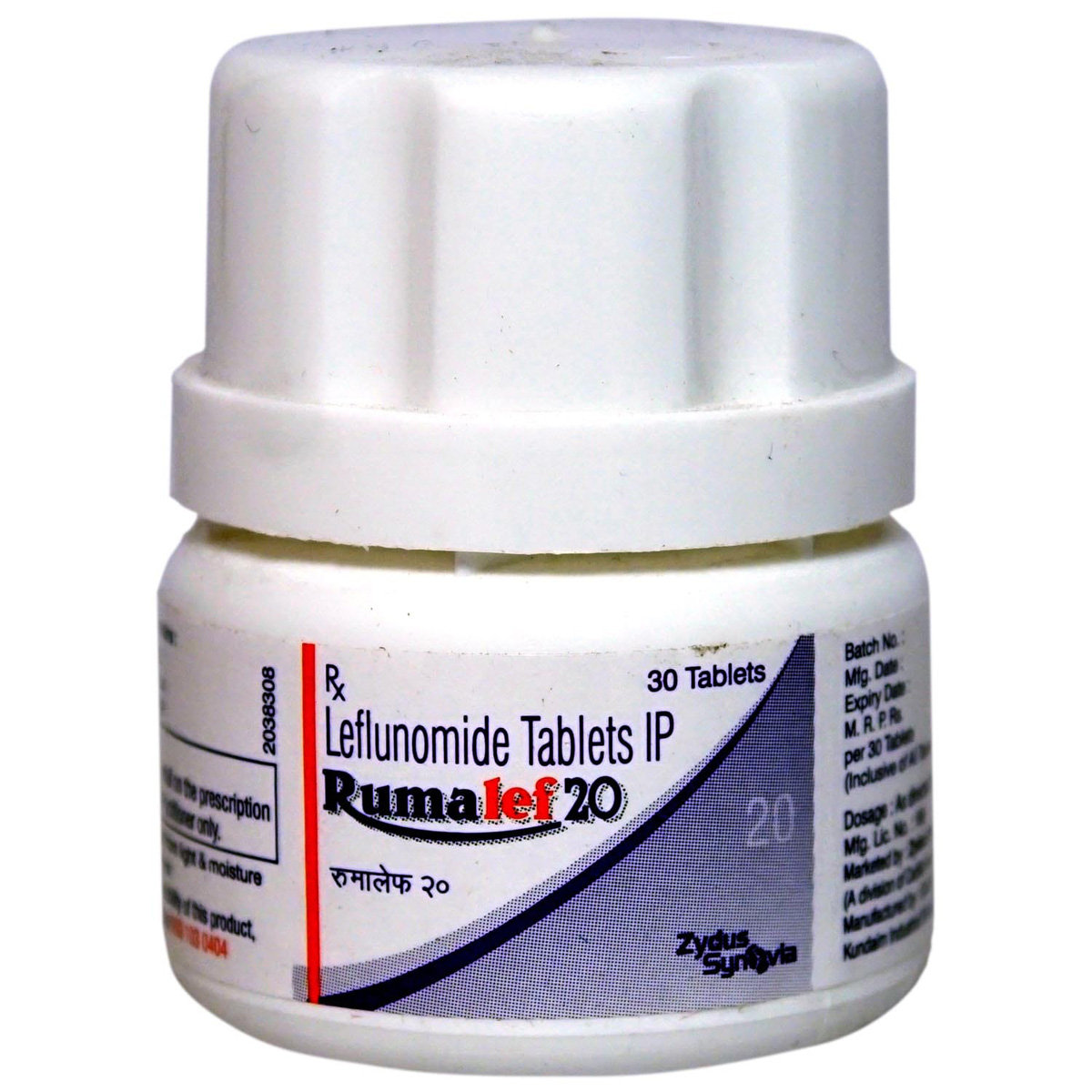
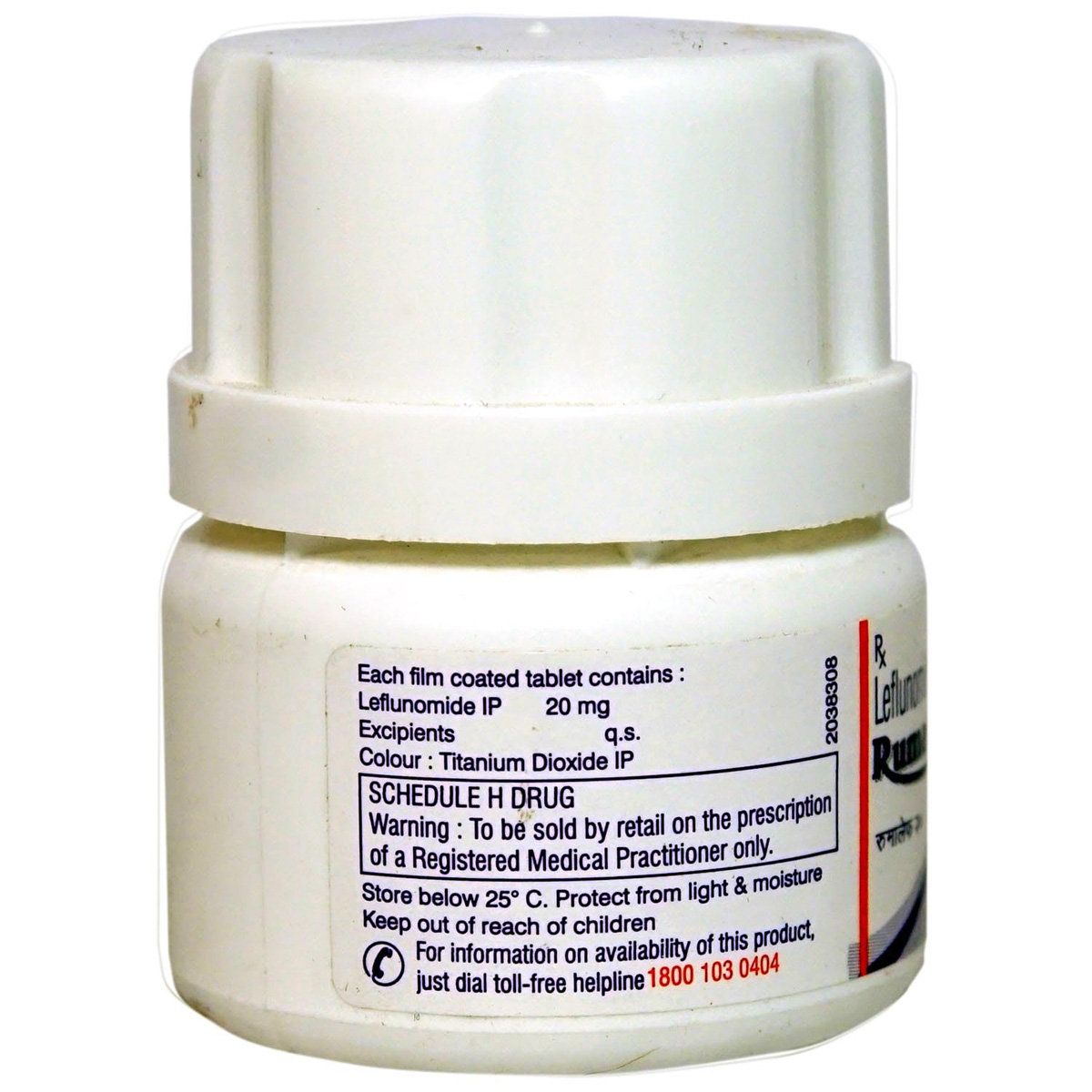


MRP ₹615
(Inclusive of all Taxes)
₹92.3 Cashback (15%)
Provide Delivery Location
Online payment accepted
 Prescription drug
Prescription drugWhats That
Composition :
Manufacturer/Marketer :
Consume Type :
Return Policy :
Expires on or after :
About Rumalef 20 Tablet
Rumalef 20 Tablet belongs to the group of medicines called 'anti-rheumatic agents' used to relieve symptoms of rheumatoid arthritis and psoriatic arthritis. Rheumatoid arthritis is an auto-immune disease (the body's immune system attacks its tissue) which leads to joint pain and damage. Psoriatic arthritis is a kind of inflammatory arthritis which occurs in patients with psoriasis (red patches of skin with silvery scales).
Rumalef 20 Tablet contains 'Leflunomide' an isoxazole immunomodulatory agent which works by blocking the formation of genetic material, i.e. DNA required for survival of replicating (dividing) cells of the immune system. As a result, it suppresses the activated immune system to reduce pain, inflammation and swelling.
Take Rumalef 20 Tablet at the same time every day as prescribed by your doctor. In some cases, Rumalef 20 Tablet may cause common side-effects such as diarrhoea, nausea, stomach pain, indigestion, rash, and hair loss. Most of these side effects do not require medical attention and will resolve gradually over time. However, you are advised to talk to your doctor if you experience these side effects persistently.
Do not take Rumalef 20 Tablet if you are pregnant or planning for pregnancy as Rumalef 20 Tablet may cause serious congenital disabilities. Rumalef 20 Tablet should not be taken by breastfeeding mothers as it passes into breast milk. Rumalef 20 Tablet may cause dizziness, so drive with caution. Avoid consuming alcohol along with Rumalef 20 Tablet as it could lead to increased dizziness and liver damage. Rumalef 20 Tablet may make you more susceptible to infections; consult your doctor if you develop any signs of infections such as fever, sore throat, breathlessness, jaundice, unexplained bleeding or bruising.
Uses of Rumalef 20 Tablet
Directions for Use
Medicinal Benefits
Rumalef 20 Tablet belongs to the group of medicines called anti-rheumatic agents used to relieve symptoms of rheumatoid arthritis and psoriatic arthritis. Rumalef 20 Tablet is a disease-modifying antirheumatic drug (DMARDs) which inhibits an enzyme called dihydroorotate dehydrogenase and has antiproliferative activity (suppresses the cell growth). Thereby, helps in treating inflammation, redness, and swelling.
Storage
- Inform Your Doctor: Notify your doctor immediately about your diarrhoea symptoms. This allows them to adjust your medication or provide guidance on managing side effects.
- Stay Hydrated: Drink plenty of fluids to replace lost water and electrolytes. Choose water, clear broth, and electrolyte-rich drinks. Avoid carbonated or caffeinated beverages to effectively rehydrate your body.
- Follow a Bland Diet: Eat easy-to-digest foods to help firm up your stool and settle your stomach. Try incorporating bananas, rice, applesauce, toast, plain crackers, and boiled vegetables into your diet.
- Avoid Trigger Foods: Steer clear of foods that can worsen diarrhoea, such as spicy, fatty, or greasy foods, high-fibre foods, and dairy products (especially if you're lactose intolerant).
- Practice Good Hygiene: Maintain good hygiene to prevent the spread of infection. To stay healthy, wash your hands frequently, clean and disinfect surfaces regularly, and avoid exchanging personal belongings with others.
- Take Anti-Diarrheal Medications: If your doctor advises, anti-diarrheal medications such as loperamide might help manage diarrhoea symptoms. Always follow your doctor's directions.
- Keep track of your diarrhoea symptoms. If they don't get better or worse or are accompanied by severe stomach pain, blood, or dehydration signs (like extreme thirst or dark urine), seek medical help.
- Take medications with food (if recommended): It can help prevent stomach distress and indigestion.
- Eat smaller, more frequent meals: Divide daily food intake into smaller, more frequent meals to ease digestion.
- Avoid trigger foods: Identify and avoid foods that trigger indigestion, such as spicy, fatty, or acidic foods.
- Stay upright after eating: Sit or stand upright for at least 1-2 hours after eating to prevent stomach acid from flowing into the oesophagus.
- Avoid carbonated drinks: Avoid drinking carbonated beverages, such as soda or beer, which can worsen indigestion.
- Manage stress: To alleviate indigestion, engage in stress-reducing activities like deep breathing exercises or meditation.
- Consult a doctor if needed: If indigestion worsens or persists, consult a healthcare professional to adjust the medication regimen or explore alternative treatments.
- Eat protein-rich foods like fish, poultry, eggs, and legumes.
- Include foods with minerals and vitamins essential for hair health.
- Join a support group to connect with others experiencing hair loss.
- Openly discuss your feelings about hair loss.
- Consider covering up with wigs, hats, or scarves.
- Be patient and avoid seeking miracle cures.
- Hydrate your body: Drink enough water to prevent dehydration and headaches.
- Calm Your Mind: Deep breathing and meditation can help you relax and relieve stress.
- Rest and Recharge: Sleep for 7-8 hours to reduce headache triggers.
- Take rest: lie down in a quiet, dark environment.
- Cold or warm compresses can help reduce tension.
- Stay Upright: Maintain good posture to keep symptoms from getting worse.
- To treat headaches naturally, try acupuncture or massage therapy.
- Over-the-counter pain relievers include acetaminophen and ibuprofen.
- Prescription Assistance: Speak with your doctor about more substantial drug alternatives.
- Severe Headaches: Seek emergency medical assistance for sudden, severe headaches.
- Frequent Headaches: If you get reoccurring headaches, consult your doctor.
- Headaches with Symptoms: Seek medical attention if your headaches include fever, disorientation, or weakness.
- Skin rash caused by allergies is due to irritants or allergens. Therefore, avoid contact with such irritants.
- Consult your doctor for proper medication and apply an anti-itch medication. Follow the schedule and use the medication whenever needed.
- Protect your skin from extreme heat and try to apply wet compresses.
- Soak in the cool bath, which gives a soothing impact to the affected area.
Drug Warnings
Do not take Rumalef 20 Tablet if you are allergic to leflunomide, have severe liverkidney problems, low levels of protein in the blood, immune system problems, bone marrow problems, or serious infections. Rumalef 20 Tablet is not recommended to be used in pregnant women, lactating mothers and people below 18 years of age. Talk to your doctor before taking Rumalef 20 Tablet if you have/had serious infections like interstitial lung disease (inflammation of lungs), tuberculosis (TB), or pneumonia. Rumalef 20 Tablet may cause dizziness, so drive with caution. Rumalef 20 Tablet may make you more susceptible to infections; notify the doctor if you develop infections, sore throat, breathlessness, jaundice, unexplained bleeding or bruising.
Drug-Drug Interactions
Drug-Drug Interactions
Login/Sign Up
Coadministration of Mefenamic acid with Rumalef 20 Tablet can increase the risk or severity of liver disease.
How to manage the interaction:
Taking Mefenamic acid with Rumalef 20 Tablet together can result in an interaction, it can be taken if your doctor has advised it. However, if you notice any symptoms of fever, chills, joint pain or swelling, unusual bleeding or bruising, skin rash, itching, loss of appetite, fatigue, nausea, vomiting, dark-colored urine, light-colored stools, and/or yellowing of the skin or eyes, you should contact a doctor immediately. Do not stop using any medications without talking to a doctor.
Co-administration of divalproex and Rumalef 20 Tablet can increase the risk of liver problems.
How to manage the interaction:
Although there is an interaction between divalproex and Rumalef 20 Tablet, they can be taken together if prescribed by a doctor. However, consult a doctor if you experience fever, chills, joint pain or swelling, unusual bleeding or bruising, skin rash, itching, less desire to eat, fatigue, nausea, vomiting, abdominal pain, and/or yellowing of the skin or eyes. Do not discontinue any medications without consulting a doctor.
Rumalef 20 Tablet can cause liver issues, and combining it with bupropion, can enhance the risk.
How to manage the interaction:
Co-administration of bupropion along with Rumalef 20 Tablet can lead to interaction, it can be taken if recommended by a doctor. If you experience fever, chills, joint pain or swelling, unusual bleeding or bruising, skin rash, itching, loss of appetite, fatigue, nausea, vomiting, abdominal pain, dark-colored urine, light-colored stools, or yellowing of the skin or eyes, contact the doctor right away. Do not discontinue any medications without consulting a doctor.
Taking asparaginase with Rumalef 20 Tablet may raise the risk of severe infections, and liver problems.
How to manage the interaction:
Although there is an interaction between asparaginase and Rumalef 20 Tablet, they can be taken together if prescribed by a doctor. However, consult a doctor if you experience fatigue, dizziness, lightheadedness, unusual bleeding or bruising, fever, chills, diarrhea, sore throat, muscle aches, shortness of breath, weight loss, red or inflamed skin, body sores, and pain or burning during urination. Do not discontinue any medications without consulting a doctor.
Taking Rumalef 20 Tablet with afatinib can increase the risk of liver problems.
How to manage the interaction:
Although there is an interaction between Rumalef 20 Tablet and afatinib, they can be taken together if prescribed by a doctor. However, consult a doctor if you experience fever, chills, joint pain or swelling, unusual bleeding or bruising, skin rash, itching, loss of appetite, fatigue, nausea, vomiting, abdominal pain, and/or yellowing of the skin or eyes. Do not discontinue any medications without consulting a doctor.
Taking adalimumab with Rumalef 20 Tablet can increase the risk of side effects.
How to manage the interaction:
Although taking Rumalef 20 Tablet and Adalimumab together can cause an interaction, they can be taken together if prescribed by a doctor. However, consult a doctor if you experience fatigue, dizziness, lightheadedness, unusual bleeding or bruising, fever, chills, diarrhea, sore throat, muscle aches, shortness of breath, weight loss, red or inflamed skin, body sores, pain or burning during urination. Do not discontinue any medications without consulting a doctor.
Co-administration of Rumalef 20 Tablet and sodium valproate can increase the risk of causing liver problems.
How to manage the interaction:
Co-administration of Rumalef 20 Tablet and sodium valproate can lead to an interaction, they can be taken together if prescribed by a doctor. However, if you experience fever, chills, joint pain or swelling, unusual bleeding or bruising, skin rash, itching, less desire to eat, fatigue, nausea, vomiting, abdominal pain, or yellowing of the skin or eyes, contact a doctor immediately. Do not discontinue any medications without consulting a doctor.
Coadministration of Disulfiram and Rumalef 20 Tablet can increase the risk of liver problems.
How to manage the interaction:
There may be a possibility of interaction between Disulfiram and Rumalef 20 Tablet, but it can be taken if prescribed by a doctor. If you have any of these symptoms fever, vomiting, stomach pain, dark urine, or yellowing of skin and eyes, contact your doctor right away. Do not discontinue any medications without consulting your doctor.
The combined use of Rumalef 20 Tablet and Hydrocortisone can increase the risk of infections.
How to manage the interaction:
Co-administration of Rumalef 20 Tablet and hydrocortisone can lead to an interaction, it can be taken if advised by your doctor. However, if you experience any symptoms like fever, chills, diarrhea, sore throat, muscle aches, shortness of breath, blood in phlegm, weight loss, red or inflamed skin, body sores, and pain or burning during urination, consult the doctor immediately. Do not stop using any medications without a doctor's advice.
Taking anakinra with Rumalef 20 Tablet can increase the risk of side effects such as bleeding problems or infections.
How to manage the interaction:
Although there is an interaction between Rumalef 20 Tablet and anakinra, they can be taken together if prescribed by a doctor. However, consult a doctor if you experience fatigue, dizziness, lightheadedness, unusual bleeding or bruising, fever, chills, diarrhea, sore throat, muscle aches, shortness of breath, weight loss, red or inflamed skin, body sores, and pain or burning during urination. Do not discontinue any medications without consulting a doctor.
Drug-Food Interactions
Drug-Food Interactions
Login/Sign Up
Diet & Lifestyle Advise
- Physical activity helps in strengthening muscles and relieves joint stiffness. Gentle activities like 20-30minutes of walking or swimming would be helpful.
- Performing yoga may also help in improving joint flexibility and pain management.
- Maintain a healthy weight by performing regular low-strain exercises and eating healthy food.
- Get adequate sleep as resting the muscles can help in reducing inflammation and swelling.
- De-stress yourself by meditating, reading books, taking a warm bubble bath or listening to soothing music.
- Acupuncture, massage and physical therapy may also be helpful.
- Eat food rich in antioxidants such as berries, spinach, kidney beans, dark chocolate, etc.
- Foods containing flavonoids help in reducing inflammation. These include soy, berries, broccoli, grapes and green tea.
- Avoid smoking and alcohol consumption.
Side Effects of Rumalef 20 Tablet
- Diarrhoea
- Nausea
- Stomach pain
- Indigestion
- Rash
- Hair loss
Habit Forming
Therapeutic Class
All Substitutes & Brand Comparisons
RX
Rheulef 20 Tablet 10's
Newgen Life Sciences Pvt Ltd
₹170
(₹15.3 per unit)
17% CHEAPERRX
Out of StockLEF 20 mg Tablet 10's
Meddox Formulations
₹170
(₹15.3 per unit)
17% CHEAPERRX
Out of StockArava 20 mg Tablet 30's
Sanofi India Ltd
₹571.1
(₹17.13 per unit)
7% CHEAPER
Product Substitutes
Author Details
We provide you with authentic, trustworthy and relevant information
Drug-Diseases Interactions
Drug-Diseases Interactions
Login/Sign Up
FAQs
Rumalef 20 Tablet is a disease-modifying antirheumatic drug (DMARD) which stops DNA (genetic material) of the provoked immune system cells required for its survival. Thereby, helps in treating inflammation, redness, and swelling at the damaged site (especially joint).
Rumalef 20 Tablet may cause diarrhoea. Drink plenty of fluids and eat non-spicy food if you experience diarrhoea. If you find blood in stools (tarry stools) or if you experience severe diarrhoea consult your doctor. Do not take anti-diarrheal medicine on your own.
It might take 4-6 weeks before you notice any benefit. In some cases, it might also take 6 months for you to feel the full effect of Rumalef 20 Tablet . Take Rumalef 20 Tablet for as long as your doctor has prescribed to treat your condition effectually.
Inform your doctor if you have liver disease, kidney disease, weak immune system and serious infections like pneumonia, or tuberculosis (TB).
Drug-Drug Interactions Checker List
- IBUPROFEN
- NAPROXEN
- ACETAMINOPHEN
- ASPIRIN
- DULOXETINE
- PREDNISONE
- CELECOXIB
- AZATHIOPRINE
- MELOXICAM
- METHOTREXATE
- ETANERCEPT
- ADALIMUMAB
- ABATACEPT
- INFLIXIMAB
- HYDROXYCHLOROQUINE
Special Advise
Regular blood tests to monitor your liver function after starting Rumalef 20 Tablet , and for every 6-8 weeks are advised.
Disease/Condition Glossary
Rheumatoid arthritis: It is an auto-immune disease (where the body's immune system attacks its tissue) which leads to joint pain and damage. Symptoms of rheumatoid arthritis include pain, inflammation of joints, difficulty in moving and swelling. Patients with rheumatoid arthritis have intense joint pain (especially knee joint) with stiffness.
Psoriatic arthritis: Psoriatic arthritis is an autoimmune disease characterized by inflammation of the skin (psoriasis) and joints (inflammatory arthritis). It mainly affects large joints in the lower extremities, distal joints of toes and fingers, back and pelvis. Symptoms include inflammation of joints, difficulty moving, swelling, patches of red, scaly skin and pain.

Have a query?
Buy best Orthopedics products by
Sun Pharmaceutical Industries Ltd
Cipla Ltd
Lupin Ltd
Intas Pharmaceuticals Ltd
Alkem Laboratories Ltd
Abbott India Ltd
Zydus Healthcare Ltd
Zydus Cadila
Torrent Pharmaceuticals Ltd
Ipca Laboratories Ltd
Macleods Pharmaceuticals Ltd
Ajanta Pharma Ltd
Dr Reddy's Laboratories Ltd
Glenmark Pharmaceuticals Ltd
Vasu Organics Pvt Ltd
Hetero Healthcare Pvt Ltd
Leeford Healthcare Ltd
Wallace Pharmaceuticals Pvt Ltd
Emcure Pharmaceuticals Ltd
Msn Laboratories Pvt Ltd
Overseas Health Care Pvt Ltd
Aar Ess Remedies Pvt Ltd
Alembic Pharmaceuticals Ltd
Cadila Healthcare Ltd
Chemo Healthcare Pvt Ltd
Corona Remedies Pvt Ltd
East West Pharma India Pvt Ltd
Eleadora Pharma
GlaxoSmithKline Pharmaceuticals Ltd
Inga Laboratories Pvt Ltd
Mankind Pharma Pvt Ltd
Medsol India Overseas Pvt Ltd
Micro Labs Ltd
Natco Pharma Ltd
Olcare Laboratories Pvt Ltd
Pharmed Ltd
Pulse Pharmaceuticals
Synovion Laboratories Pvt Ltd
Talent India Pvt Ltd
Virchow Biotech Pvt Ltd
Akumentis Healthcare Ltd
Ankaa Pharmaceutical
Bioelite Lifesciences Pvt Ltd
Blisson Mediplus Pvt Ltd
Cell Salve Pharmaceutical
Dolvis Bio Pharma Pvt Ltd
Eins Pharmaceuticals
Genesis Biotech
La Renon Healthcare Pvt Ltd
Neon Laboratories Ltd
Novartis India Ltd
Panacea Biotec Ltd
Pfizer Ltd
Prevego Healthcare & Research Pvt Ltd
Ronyd Healthcare Pvt Ltd
Steris Healthcare
Sundyota Numandis Pharmaceuticals Pvt Ltd
Actus Health Care
Alna Biotech Pvt Ltd
Alteus Biogenics Pvt Ltd
Anthem Bio Pharma
Aten Remedies Pvt Ltd
Athens Labs Ltd
Aureate Healthcare
Aurolab
Avrohn Pharma (I) Ltd
Biorange Biologicals Pvt Ltd
Biorex Healthcare Pvt Ltd
CMG Biotech Pvt Ltd
Canixa Life Sciences Pvt Ltd
Celebrity Biopharma Ltd
Celera Healthcare Pvt Ltd
Celon Laboratories Pvt Ltd
Comed Chemicals Ltd
Cyrus Remedies Pvt Ltd
Dru Pharma Pvt Ltd
Edura Pharmaceuticals Pvt Ltd
Elder Pharmaceuticals Ltd
Energize Pharmaceuticals (P) Ltd
Fibovil Pharmaceuticals Pvt Ltd
Goddres Pharmaceuticals Pvt Ltd
Gufic Bioscience Ltd
Hiilsen Life Sciences Pvt Ltd
Iifa Healthcare
Intra Labs India Pvt Ltd
Jagsonpal Pharmaceuticals Ltd
Krishgir Pharmaceuticals Pvt Ltd
Lg Life Sciences India Pvt Ltd
Mastro Biologicals Pvt Ltd
Maverick Pharma Pvt Ltd
Medicure Life Sciences Pvt Ltd
Medieos Life Sciences Llp
Medley Pharmaceuticals Ltd
Meyer Organics Pvt Ltd
Organic Pharmaceuticals Pvt Ltd
Qurewell Health Science Pvt Ltd
R B Pharmaceuticals
RPG Life Sciences Ltd
Ravinor Lifesciences
Regenix Drugs Ltd
Alcohol
Unsafe
You are recommended to avoid alcohol consumption while taking Rumalef 20 Tablet . Alcohol intake, along with Rumalef 20 Tablet , may cause liver disease.
Pregnancy
Unsafe
It is not recommended to take Rumalef 20 Tablet while you are pregnant. Rumalef 20 Tablet may cause serious birth defects.
Breast Feeding
Unsafe
It is not recommended to take Rumalef 20 Tablet while you are breastfeeding. Rumalef 20 Tablet passes into breast milk.
Driving
Caution
Rumalef 20 Tablet may cause dizziness and tiredness; do not drive or operate heavy machinery if you feel dizzy.
Liver
Caution
Please consult your doctor if you have liver impairment before taking Rumalef 20 Tablet .
Kidney
Caution
Please consult your doctor if you have kidney impairment before taking Rumalef 20 Tablet .
Children
Unsafe
Rumalef 20 Tablet is not approved for children under the age of 18 years.





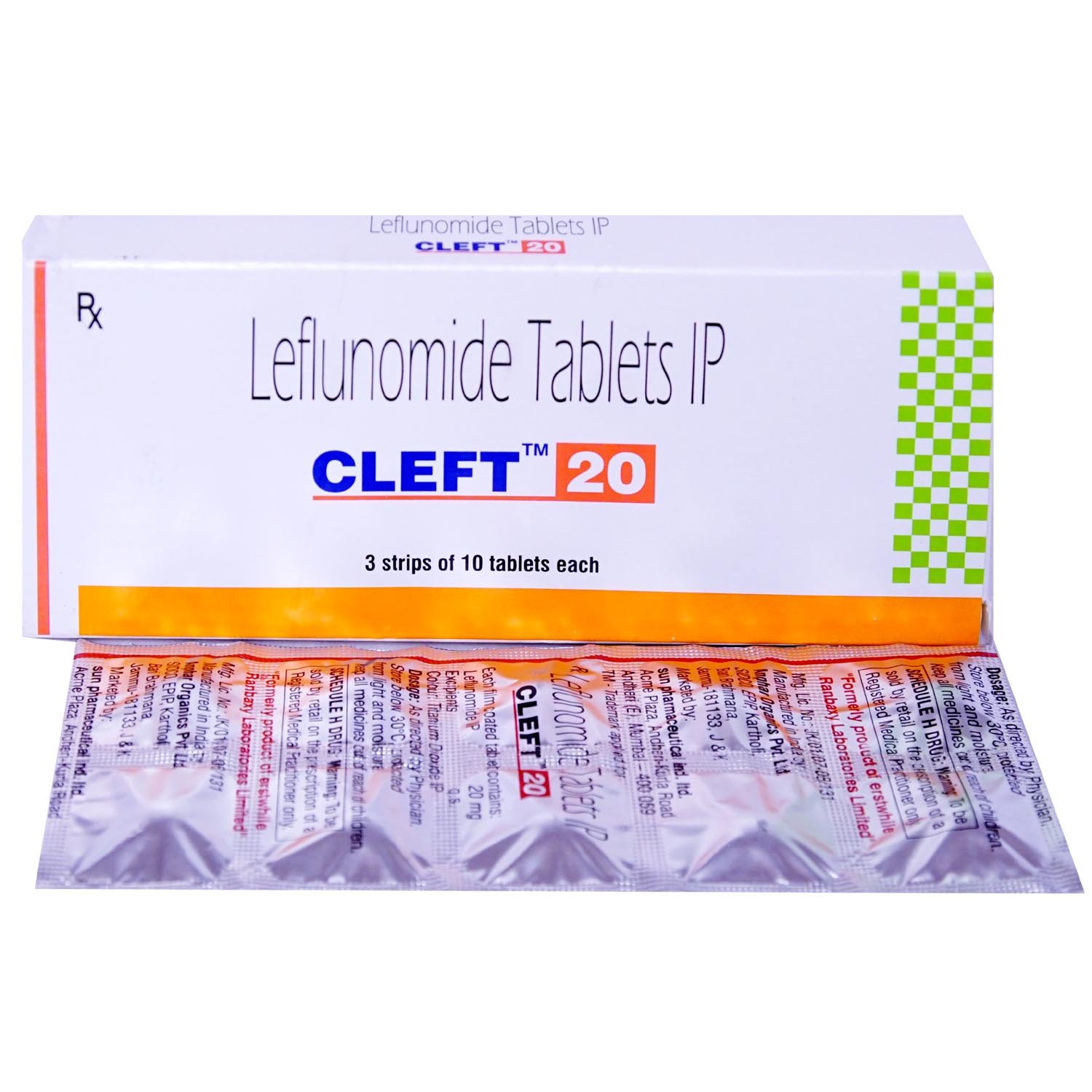
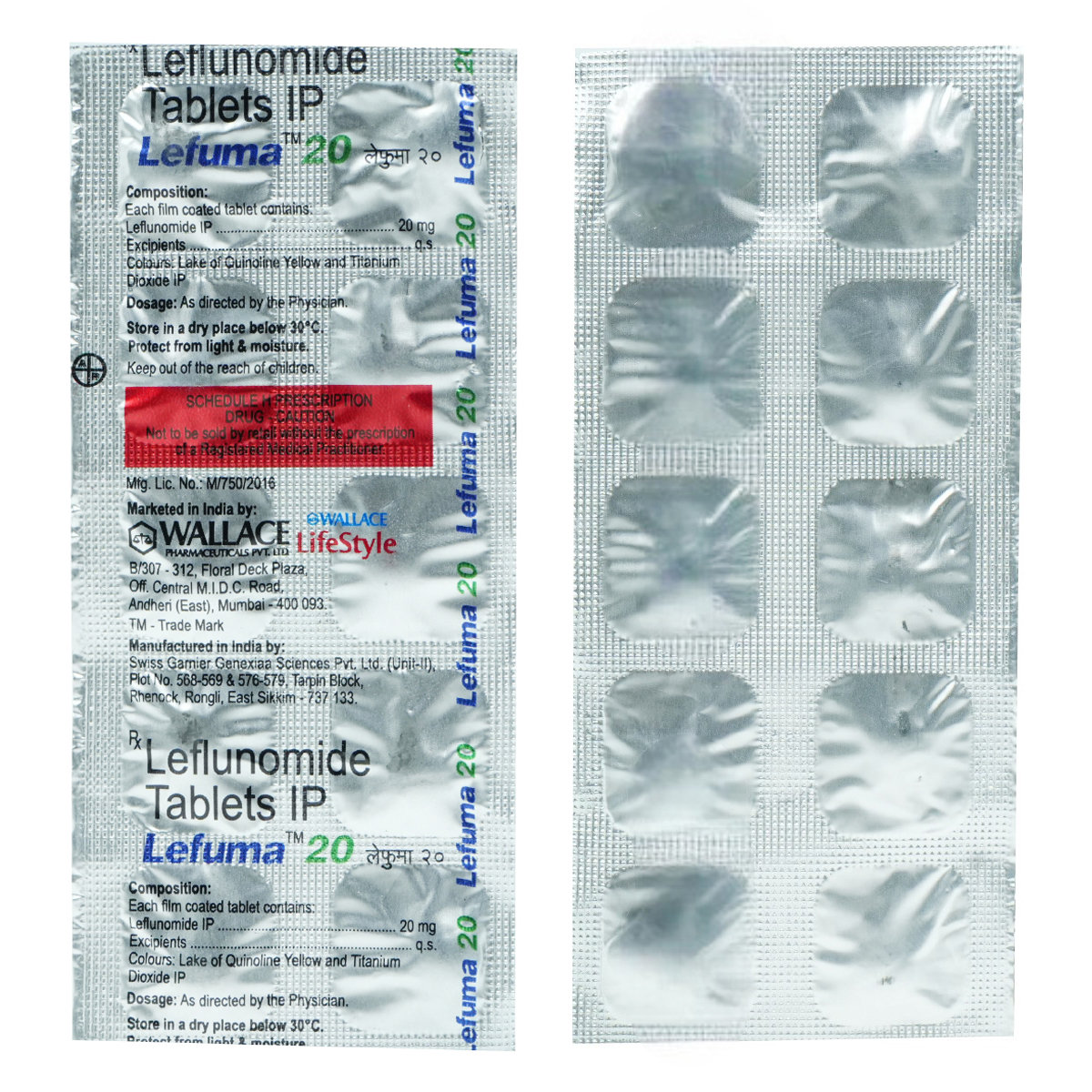
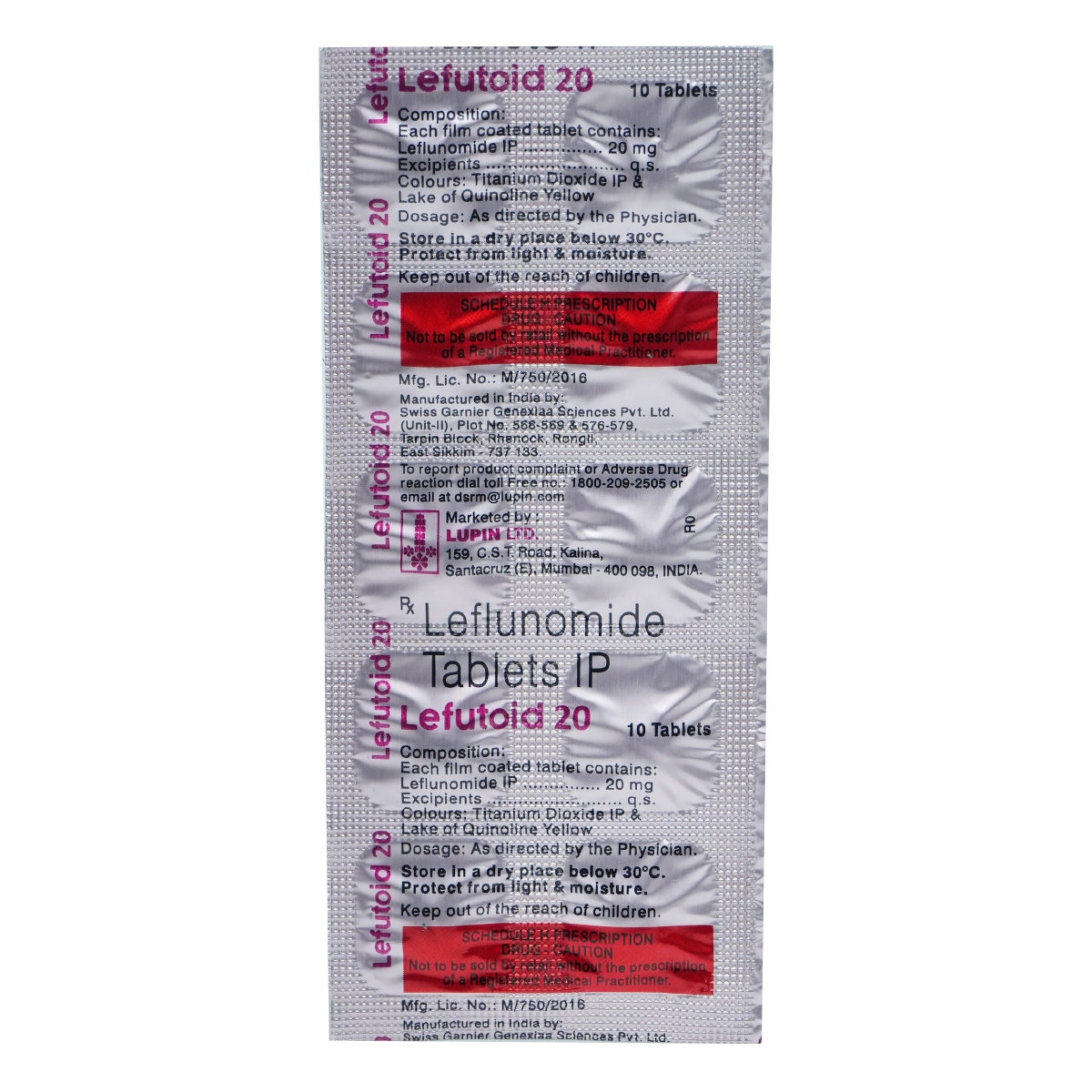

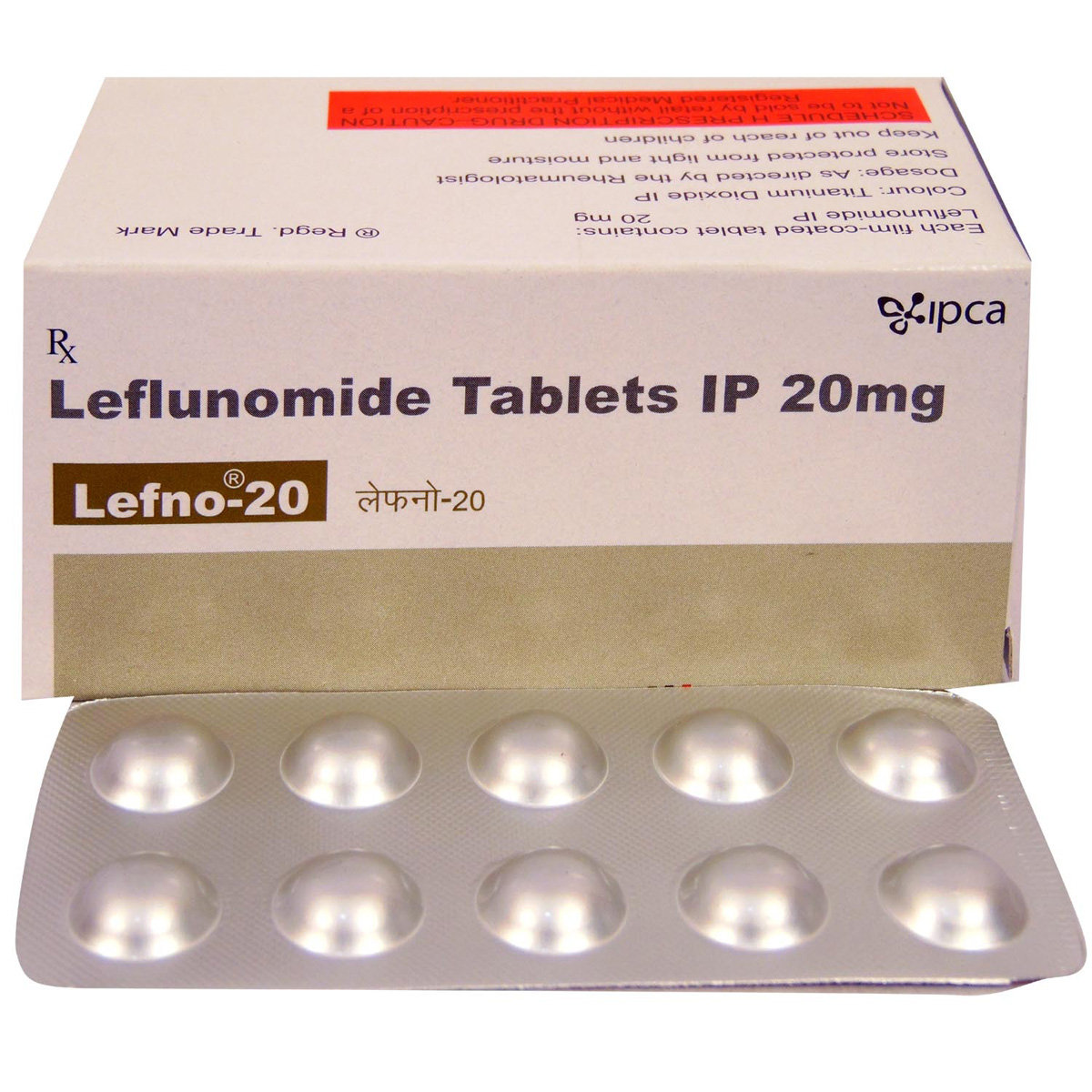


_0.jpg?tr=q-85)

